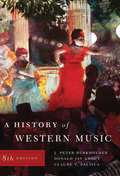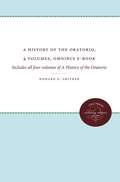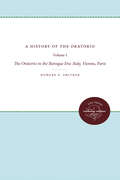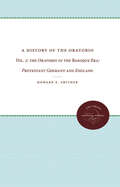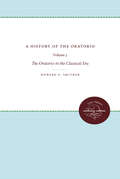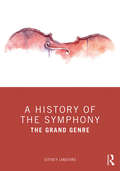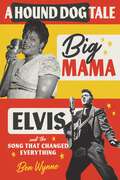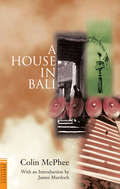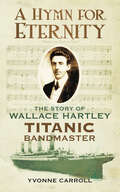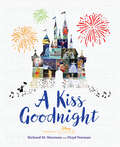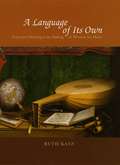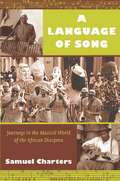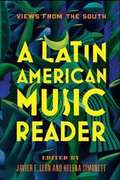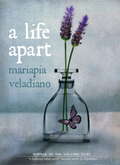- Table View
- List View
A History of Western Music (8th edition)
by J. Peter Burkholder Donald Jay Grout Claude V. PaliscaThe Eighth Edition of A History of Western Music is a vivid, accessible, and richly contextual view of music in Western culture.
A History of Women's Lives in Hove and Portslade
by Judy MiddletonThis book looks at the lives of the women from Hove and Portslade, ranging from artists, musicians, writers, performers, reformers, pioneering doctors and business-women to those employed in factories, shops, laundries and as domestic servants, not forgetting, of course, women's contribution to war-work in both of the world wars. There are facts about their ordinary lives, birth, marriage and death; their education; their leisure activities from guns to cycling, the gym, swimming and horse riding.It is also appropriate to reflect on the Votes for Women movement, when brave souls battled against prejudice to achieve the franchise. Not all women felt the same, of course, and although there was apathy at first, Brighton and Hove was home to an early group of suffragists who were passionate in their beliefs but disliked the violence embraced by the suffragettes.If you ever thought women deserved more than being a mere footnote in history, then this is the book for you.
A History of the Oratorio, 4 volumes, Omnibus E-book
by Howard E. SmitherThe University of North Carolina Press is proud to announce Howard Smither's ground-breaking four-volume A History of the Oratorio, are now available in one convenient Omnibus E-Book edition. Published as UNC Press Enduring Editions, these volumes bring Smither's landmark scholarship to a new generation of readers and scholars.Written by an eminent scholar in a style that represents American musicological writing at its communicative best, A History of the Oratorio offers a synthesis and critical appraisal so exhaustive and reliable that the serious student of the oratorio will be compelled to look to these volumes as an indispensable source. No work on the history of the oratorio has yet appeared in the English language that is comparable in scope and treatment with Smither's comprehensive four-volume work.Volumes 1 and 2, published by the University of North Carolina Press in 1977, treated the oratorio in the Baroque era, while Volume 3, published in 1987, explored the genre in the Classical era. The final volume, Volume 4, published in 2000, surveys the history of nineteenth- and twentieth-century oratorio, stressing the main geographic areas of oratorio composition and performance: Germany, Britain, America, and France.A History of the Oratorio is the first full-length history of the genre since Arnold Schering published his Geschichte des Oratoriums in 1911. In addition to synthesizing current thought about the oratorio, these volumes contribute new information on relationships between oratorio librettos and contemporary literary and religious thought, and on the musical differences among oratorios from different geographical-cultural regions.Information on the 4 volumes included in this Omnibus E-Book:A HISTORY OF THE ORATORIOHoward E. SmitherVolume 1: The Oratorio in the Baroque Era: Italy, Vienna, Paris507 pp., 59 illus., 74 music examplesVolume 2: the Oratorio in the Baroque Era: Protestant Germany and England415 pp., 48 illus., 75 music examplesVolume 3: the Oratorio in the Classical Era736 pp., 37 illus., 30 tables, 110 music examplesVolume 4: The Oratorio in the Nineteenth and Twentieth Centuries856 pp., 24 illus., 33 tables, 90 figs.About UNC Press Enduring Editions UNC Press Enduring Editions use the latest in digital technology to make available again books from our distinguished backlist that were previously out of print. These editions are published unaltered from the original, and are presented in affordable paperback formats, bringing readers both historical and cultural value.
A History of the Oratorio: Vol. 1: The Oratorio in the Baroque Era: Italy, Vienna, Paris
by Howard E. SmitherHoward Smither has written the first definitive work on the history of the oratorio since Arnold Schering published his Geschichte des Oratoriums in 1911. This volume is the first of a four-volume comprehensive study that offers a new synthesis of what is known to date about the oratorio.Volume 1, divided into three parts, opens with the examination of the medieval, Renaissance, and early Baroque antecedents and origins of the oratorio, with emphasis on Rome and Philip Neri's Congregation of the Oratory and with special attention to the earliest works for which the term oratorio seems appropriate. The second part recounts the development of the oratorio in Italy, circa 1640-1720. It reviews the social contexts, patrons, composers, poets, librettos, and music of the oratorio in Italy, especially in Vienna and Paris. The procedure adapted throughout the work is to treat first the social context, particularly the circumstances of performance of the oratorio in a given area and period, then to treat the libretto, and finally the music. For each geographic area and period, the author has selected for special attention a few oratorios that appear to be particularly important or representative. He has verified the information offered in the specialized literature whenever possible by reference to the music or documents. In a number of areas, particular seventeenth-century Italy, in which relatively few previous studies have been undertaken or secondary sources have proven to be inadequate, the author has examined the primary sources in manuscript and printed form -- music, librettos, and documents of early oratorio history. Impressive research and intelligent integration of disparate elements make this complicated, diffuse subject both readable and accessible to the student of music.Volume 2, The Oratorio in the Baroque Era: Protestant Germany and England, and Volume 3, The Oratorio in the Classical Era, continue and expand the study of oratorio history. Although this series was originally announced as a three-volume study, Smither will conclude with a fourth volume.This new work--the first English-language study of the history of the oratorio will become the standard work on its subject and an enduring contribution to music and scholarship.Originally published in 1977.A UNC Press Enduring Edition -- UNC Press Enduring Editions use the latest in digital technology to make available again books from our distinguished backlist that were previously out of print. These editions are published unaltered from the original, and are presented in affordable paperback formats, bringing readers both historical and cultural value.
A History of the Oratorio: Vol. 2: the Oratorio in the Baroque Era: Protestant Germany and England
by Howard E. SmitherWritten by an eminent scholar in a style that represents American musicological writing at its communicative best, A History of the Oratorio offers a synthesis and critical appraisal so exhaustive and reliable that the serious student of the oratorio will be compelled to look to these volumes as an indispensable source. No work on the history of the oratorio has yet appeared in the English language that is comparable in scope and treatment with Howard Smither's comprehensive four-volume work.The first part of volume 2 examines in depth the antecedents and origins of the oratorio in Protestant Germany in the seventeenth century. It includes discussions of the Lutheran Historia, sacred dramatic dialogues, and the Lubeck Abendmusiken of Buxtehude. The second part treats the oratorio in Protestant Germany in the early eighteenth century and examines Handel, Reinhard Keiser, and J.S. Bach. The third part considers primarily the English oratorios of Handel. In most sections of A History of the Oratorio, the author has selected for special attention a few oratorios that are representative of each geographical area and period. An exception to this procedure is in the section on Handel in this volume, where all of the composer's English oratorios are treated fully with particular reference to recent specialized Handel studies.Volume 1, The Oratorio in the Baroque Era: Italy, Vienna, Paris, and Volume 3, The Oratorio in the classical Era, expand and continue the study of oratorio history. Although this series was originally announced as a three-volume study, Smither will conclude with a fourth volume.Originally published in 1977. A UNC Press Enduring Edition -- UNC Press Enduring Editions use the latest in digital technology to make available again books from our distinguished backlist that were previously out of print. These editions are published unaltered from the original, and are presented in affordable paperback formats, bringing readers both historical and cultural value.
A History of the Oratorio: Vol. 3: the Oratorio in the Classical Era
by Howard E. SmitherThe Oratorio in the classical Era is the third volume of Howard Smither's monumental History of the Oratorio, continuing his synthesis and critical appraisal of the oratorio. His comprehensive study surpasses in scope and treatment all previous works on the subject. A fourth and final volume, on the oratorio in the nineteenth and twentieth centuries, is forthcoming.In this volume Smither discusses the Italian oratorio from the 1720s to the early nineteenth century and oratorios from other parts of Europe from the 1750s to the nineteenth century. Drawing on works that represent various types, languages, and geographical areas, Smither treats the general characteristics of oratorio libretto and music and analyzes twenty-two oratorios from Italy, England, Germany, France, and Russia. He synthesizes the results of specialized studies and contributes new material based on firsthand study of eighteenth-century music manuscripts and printed librettos. Emphasizing the large number of social contexts within which oratorios were heard, Smither discussed examples in Italy such as the Congregation of the Oratory, lay contrafraternities, and educational institutions. He examines oratorio performances in German courts, London theaters and English provincial festivals, and the Parisian Concert spirituel. Though the volume concentrates primarily on eighteenth-century oratorio from the early to the late Classical styles, Smither includes such transitional works as the oratorios of Jean-Francios le Seur in Paris and Stepan Anikievich Degtiarev in Moscow.A History of the Oratorio is the first full-length history of the genre since Arnold Schering's 1911 study. In addition to synthesizing current thought about the oratorio, this volume contributes new information on relationships between oratorio librettos and contemporary literary and religious thought, and on the musical differences among oratorios from different geographical-cultural regions.Originally published in 1987.A UNC Press Enduring Edition -- UNC Press Enduring Editions use the latest in digital technology to make available again books from our distinguished backlist that were previously out of print. These editions are published unaltered from the original, and are presented in affordable paperback formats, bringing readers both historical and cultural value.
A History of the Oratorio: Vol. 4: The Oratorio in the Nineteenth and Twentieth Centuries
by Howard E. SmitherWith this volume, Howard Smither completes his monumental History of the Oratorio. Volumes 1 and 2, published by the University of North Carolina Press in 1977, treated the oratorio in the Baroque era, while Volume 3, published in 1987, explored the genre in the Classical era. Here, Smither surveys the history of nineteenth- and twentieth-century oratorio, stressing the main geographic areas of oratorio composition and performance: Germany, Britain, America, and France.Continuing the approach of the previous volumes, Smither treats the oratorio in each language and geographical area by first exploring the cultural and social contexts of oratorio. He then addresses aesthetic theory and criticism, treats libretto and music in general, and offers detailed analyses of the librettos and music of specific oratorios (thirty-one in all) that are of special importance to the history of the genre.As a synthesis of specialized literature as well as an investigation of primary sources, this work will serve as both a springboard for further research and an essential reference for choral conductors, soloists, choral singers, and others interested in the history of the oratorio.Originally published 2000.A UNC Press Enduring Edition -- UNC Press Enduring Editions use the latest in digital technology to make available again books from our distinguished backlist that were previously out of print. These editions are published unaltered from the original, and are presented in affordable paperback formats, bringing readers both historical and cultural value.
A History of the Rutgers University Glee Club
by David F. ChapmanFounded in 1872, the Glee Club is Rutgers University’s oldest continuously active student organization, as well as one of the first glee clubs in the United States. For the past 150 years, it has represented the university and presented an image of the Rutgers man on a national and international stage. This volume offers a comprehensive history of the Rutgers Glee Club, from its origins adopting traditions from the German Männerchor and British singing clubs to its current manifestation as a world-recognized ensemble. Along the way, we meet the colorful and charismatic men who have directed the group over the years, from the popular composer and minstrel performer Loren Bragdon to the classically-trained conductor Patrick Gardner. And of course, we learn what the club has meant to the generations of talented and dedicated young men who have sung in it. A History of the Rutgers University Glee Club recounts the origins of the group’s most beloved traditions, including the composition of the alma mater’s anthem “On the Banks of the Old Raritan” and the development of the annual Christmas in Carol and Song concerts. Meticulously researched, including a complete discography of the club’s recordings, this book is a must-have for all the Rutgers Glee Club’s many fans and alumni.
A History of the Symphony: The Grand Genre
by Jeffrey LangfordA History of the Symphony: The Grand Genre identifies the underlying cultural factors that have shaped the symphony over the past three hundred years, presenting a unified view of the entire history of the genre. The text goes beyond discussions of individual composers and the stylistic evolution of the genre to address what constitutes a symphony within each historical period, describing how such works fit into the lives of composers and audiences of the time, recognizing that they do not exist in a vacuum but rather as the products of numerous external forces spurring their creation. In three parts, the text proceeds chronologically, drawing connections between musical examples across regions and eras: The Classical Symphony The Romantic Symphony The Symphony in the Modern Era Within this broad chronology—from the earliest Italian symphonies of the 18th century to the most experimental works of the 20th century—discussion of the development of the genre often breaks down along national lines that outline divergent but parallel paths of stylistic growth. In consideration of what is and is not a symphony, musical developments in other genres are presented as they relate to the symphony, genres such as the serenade, the tone poem, and the concert overture. Suitable for a one-semester course as well as a full-year syllabus, and with illustrative musical examples throughout, A History of the Symphony places composers and works in sociological and musical contexts while confronting the fundamental question: What is a symphony?
A Hit With A Bullet: A True Story Of Corruption, Greed, And The Real Murder On Music Row
by Sammy SadlerA shot rings out along Music Row in Nashville. Sammy Sadler, a rising country star at 21 years-old, feels hot blood flow out of the bullet wound in his shoulder. Adrenaline pulsed through him as a pleasant evening with friend and colleague, Kevin Hughes, took a deadly turn.A shot rings out along Music Row in Nashville. Sammy Sadler, a rising country star at 21 years-old, feels hot blood flow out of the bullet wound in his shoulder. Adrenaline pulsed through him as a pleasant evening with friend and colleague, Kevin Hughes, took a deadly turn. Another shot cries out as a masked figure emerges from the shadows. Sadler is disoriented. The driver of their car makes a mad dash up the road as more bullets pierce the air. The gunman turns his attention to one man. Kevin Hughes, Chart Director for Cash Box magazine, was shot dead on March 9th, 1989 in the middle of 16th Avenue. The murderer disappears in the shadows, seemingly getting away with the crime. Known as the Murder on Music Row played out like a movie scene, but it was a living nightmare for Sadler. The rumor mill churned ruthlessly about his &“possible involvement&” in the unsolved crime. His career and his marriage crumbled. He struggled to recover from lasting P.T.S.D. and an injury compromising the use of his hand. The mystery of that fatal night did not fade. It gained attention on national outlets such as &“Unsolved Mysteries,&” &“America&’s Most Wanted,&” &“Nancy Grace,&” and more. It wasn&’t until 2003 that former Chart Director for Cash Box magazine, Richard D&’Antionio was convicted of the murder. The closure of the conviction seems to have marked a new chapter for Sammy Sadler. The following year, he released his first album since the murder on music row, HARD ON A HEART. Building on this momentum, Sadler has gone on multiple tours, recorded several new albums, and is taking back all that was robbed of him that one night in 1989. Today, he has one message…his story is far from over.
A Hound Dog Tale: Big Mama, Elvis, and the Song That Changed Everything
by Ben WynneThe release of the song “Hound Dog” in 1953 marked a turning point in American popular culture, and throughout its history, the hit ballad bridged divides of race, gender, and generational conflict. Ben Wynne’s A Hound Dog Tale discusses the stars who made this rock ’n’ roll standard famous, from Willie Mae “Big Mama” Thornton to Elvis Presley, along with an eclectic cast of characters, including singers, songwriters, musicians, record producers and managers, famous television hosts, several lawyers, and even a gangster or two.Wynne’s examination of this American classic reveals how “Hound Dog” reflected the values and issues of 1950s American society, and sheds light on the lesser-known elements of the song’s creation and legacy. A Hound Dog Tale will capture the imagination of anyone who has ever tapped a foot to the growl of a blues riff or the bark of a rock ’n’ roll guitar.
A House in Bali
by Colin McpheeThis is a book about passion, obsession and discovery in an amazing land, but also about the voyage of a highly talented composer and writer. A House in Bali remains one of the most remarkable books ever written about the fabled island of Bali. This classic book tells the story of Balinese culture through a history of Balinese music. First published in 1947, it tells the story of the writer and composer Colin McPhee's (1900–64) obsession with a music once unknown to the West, and of his journey to Bali to experience it firsthand. In 1929, the young Canadian– born musician chanced upon rare gramophone recordings of Balinese gamelan music which were to change his life forever. From that moment, he lived for the day when he could set foot on the island where the clear, metallic music originated. He was able to realize his dreams and spent almost a decade there during the 1930's. Music of Bali and dance, as McPhee discovered to his delight, are second nature to the Balinese, and his subsequent writings and compositions proved seminal in popularizing Balinese gamelan music in the West. InA House in Bali, McPhee unfolds a beguiling picture of a society long established, staggeringly poor in Western terms, but rich beyond belief in spiritual values and joy. The young composer writes about his discoveries of music in Bali and growing understanding of an astonishing culture where the arts are a prime preoccupation, and of the arts, music is supreme. Much has been written on Bali, but this classic work from 1947 remains the only narrative by a Western musician.
A Hymn for Eternity: The Story of Wallace Hartley, Titanic Bandmaster
by Yvonne CarrollThe band playing ‘Nearer my God to Thee’ as the ship went down is probably one of the most famous stories relating to the Titanic. The bravery of the band and their leader, Wallace Hartley, is one of the endearing stories to come out of the worst disaster to happen to a British passenger liner. Who comprised the band? Who was Wallace Hartley and where did he come from? Not much has been written about this enigmatic band leader or of his part in the tragedy, beyond a few mentions in the many books on the disaster. But he was one of the most important characters in the story of Titanic. Yvonne Speak has spent years researching the life story of Wallace Hartley and has conducted interviews with remaining members of his family. Here she tells his story and remembers this most British of heroes.
A Journey Down Melody Lane
by Raju BharatanThe Hindi film song has held millions spellbound for nearly eight decades. In this unputdownable ‘labour of love’, India’s leading film song historian, Raju Bharatan, delves deep into his treasure trove to tell us how singing is all about romancing, how composing is all about feelings, how the twain, stardom and songdom, do meet to make the vintage film number a part of the nation’s psyche. He reconstructs song happenings over the last sixty years or so to condense the emotion and passion going into legendary star hook-ups, showing us how with the pairing comes the vibe, with the vibe comes the tune, and with the tune unfolds cinema that is a ‘Madhuballad’ all the way. This volume also describes the creative inputs of music directors, lyricists and singers that go into the making of a Hindi film song. It is a compendium that no one can afford to miss! Raju Bharatan is popularly recognized as the last word on film music in India – as the only one physically there ‘on the scene’ through the decades. His knowledge of Hindustani cinesangeet is matched only by his grip on Indian cricket. He now packs fifty years of musical lore into a work sure to command a niche on your bookshelf.
A Kiss Goodnight (Disney Editions Deluxe)
by Richard M. ShermanA beautifully illustrated storybook showcasing the lyrics to A Kiss Goodnight, written by Richard Sherman and heard every night at Walt Disney World and Disneyland during the fireworks shows.
A Kiss across the Ocean: Transatlantic Intimacies of British Post-Punk and US Latinidad
by Richard T. RodríguezIn A Kiss across the Ocean Richard T. Rodríguez examines the relationship between British post-punk musicians and their Latinx audiences in the United States since the 1980s. Melding memoir with cultural criticism, Rodríguez spotlights a host of influential bands and performers including Siouxsie and the Banshees, Adam Ant, Bauhaus, Soft Cell, Frankie Goes to Hollywood, and Pet Shop Boys. He recounts these bands’ importance for him and other Latinx kids and discusses their frequent identification with these bands’ glamorous performance of difference. Whether it was Siouxsie Sioux drawing inspiration from Latinx contemporaries and cultural practices or how Soft Cell singer Marc Almond’s lyrics were attuned to the vibrancy of queer Latinidad, Rodríguez shows how Latinx culture helped shape British post-punk. He traces the fandom networks that link these groups across space and time to illuminate how popular music establishes and facilitates intimate relations across the Atlantic. In so doing, he demonstrates how the music and styles that have come to define the 1980s hold significant sway over younger generations equally enthused by their matchlessly pleasurable and political reverberations.
A Language of Its Own: Sense and Meaning in the Making of Western Art Music
by Ruth KatzThe Western musical tradition has produced not only music, but also countless writings about music that remain in continuous- and enormously influential- dialogue with their subject. With sweeping scope and philosophical depth, A Language of Its Own traces the past millennium of this ongoing exchange. Ruth Katz argues that the indispensable relationship between intellectual production and musical creation gave rise to the Western conception of music. This evolving and sometimes conflicted process, in turn, shaped the art form itself. As ideas entered music from the contexts in which it existed, its internal language developed in tandem with shifts in intellectual and social history. Katz explores how this infrastructure allowed music to explain itself from within, creating a self-referential and rational foundation that has begun to erode in recent years. A magisterial exploration of a frequently overlooked intersection of Western art and philosophy, A Language of Its Own restores music to its rightful place in the history of ideas.
A Language of Song: Journeys in the Musical World of the African Diaspora
by Samuel ChartersIn A Language of Song, Samuel Charters--one of the pioneering collectors of African American music--writes of a trip to West Africa where he found "a gathering of cultures and a continuing history that lay behind the flood of musical expression [he] encountered everywhere . . . from Brazil to Cuba, to Trinidad, to New Orleans, to the Bahamas, to dance halls of west Louisiana and the great churches of Harlem. " In this book, Charters takes readers along to those and other places, including Jamaica and the Georgia Sea Islands, as he recounts experiences from a half-century spent following, documenting, recording, and writing about the Africa-influenced music of the United States, Brazil, and the Caribbean. Each of the book's fourteen chapters is a vivid rendering of a particular location that Charters visited. While music is always his focus, the book is filled with details about individuals, history, landscape, and culture. In first-person narratives, Charters relates voyages including a trip to the St. Louis home of the legendary ragtime composer Scott Joplin and the journey to West Africa, where he met a man who performed an hours-long song about the Europeans' first colonial conquests in Gambia. Throughout the book, Charters traces the persistence of African musical culture despite slavery, as well as the influence of slaves' songs on subsequent musical forms. In evocative prose, he relates a lifetime of travel and research, listening to brass bands in New Orleans; investigating the emergence of reggae, ska, and rock-steady music in Jamaica's dancehalls; and exploring the history of Afro-Cuban music through the life of the jazz musician Bebo Valds. A Language of Song is a unique expedition led by one of music's most observant and well-traveled explorers.
A Latin American Music Reader: Views from the South
by Helena Simonett Javier F LeonJavier F. León and Helena Simonett curate a collection of essential writings from the last twenty-five years of Latin American music studies. Chosen as representative, outstanding, and influential in the field, each article appears in English translation. A detailed new introduction by León and Simonett both surveys and contextualizes the history of Latin American ethnomusicology, opening the door for readers energized by the musical forms brought and nurtured by immigrants from throughout Latin America. Contributors: Marina Alonso Bolaños, José Jorge de Carvalho, Maria Ignêz Cruz Mello, Gonzalo Camacho DÃaz, Claudio F. DÃaz, Rodrigo Cantos Savelli Gomes, Juan Pablo González, Javier F. León, Rubén López Cano, Angela Lühning, Jorge MartÃnez Ulloa, Julio MendÃvil, Carlos Miñana Blasco, Raúl R. Romero, Iñigo Sánchez Fuarros, Carlos Sandroni, Carolina SantamarÃa Delgado, Helena Simonett, Rodrigo Torres Alvarado, and Alejandro Vera.
A Life Apart
by Mariapia VeladianoRebecca's parents were born to very different families. One wealthy, one all but destitute, they were united only by their striking mutual beauty. But the sole child to bless their great romantic fairy tale is a daughter of startling ugliness. The shock of having given birth to such a monster leads the mother to withdraw both herself and her daughter from the world. Only by keeping her child indoors, away from strangers' eyes, can she protect her from their disgust. But against all odds, with a little help from some remarkable friends, Rebecca discovers a talent for music that proves that inner beauty can outshine any other. A Life Apart is an irresistible modern fable that will resonate with anyone who has ever felt that they don't belong.
A Life Apart
by Mariapia VeladianoRebecca's parents were born to very different families. One wealthy, one all but destitute, they were united only by their striking mutual beauty. But the sole child to bless their great romantic fairy tale is a daughter of startling ugliness. The shock of having given birth to such a monster leads the mother to withdraw both herself and her daughter from the world. Only by keeping her child indoors, away from strangers' eyes, can she protect her from their disgust. But against all odds, with a little help from some remarkable friends, Rebecca discovers a talent for music that proves that inner beauty can outshine any other. A Life Apart is an irresistible modern fable that will resonate with anyone who has ever felt that they don't belong.
A Light That Never Goes Out
by Tony FletcherThe definitive book about The Smiths, one of the most beloved, respected, and storied indie rock bands in music history.They were, their fans believe, the best band in the world. Hailing from Manchester, England, The Smiths--Morrissey, Johnny Marr, Andy Rourke, and Mike Joyce--were critical and popular favorites throughout their mid-1980s heyday and beyond. To this day, due to their unforgettable songs and lyrics, they are considered one of the greatest British rock groups of all time--up there with the Beatles, the Stones, the Who, and the Clash. Tony Fletcher paints a vivid portrait of the fascinating personalities within the group: Morrissey, the witty, literate lead singer whose loner personality and complex lyrics made him an icon for teenagers who felt forlorn and forgotten; his songwriting partner Marr, the gregarious guitarist who became a rock god for a generation of indie kids; and the talented, good-looking rhythm section duo of bassist Rourke and drummer Joyce. Despite the band's tragic breakup at the height of their success, A Light That Never Goes Out is a celebration: the saga of four working-class kids from a northern English city who come together despite contrasting personalities, find a musical bond, inspire a fanatical following, and leave a legacy that changed the music world--and the lives of their fans.
A Light in the Darkness: The Music and Life of Joaquín Rodrigo
by Walter Aaron Clark Javier Suárez-PajaresA composer of singular vision. Joaquín Rodrigo (1901–1999) is best known as the composer of one of the most popular works of music in the twentieth century—the Concierto de Aranjuez for guitar and orchestra. It’s been featured in movies and television commercials and remains a staple of concert programs for orchestras around the world. Miles Davis said, “After listening to it for a couple of weeks…I couldn’t get it out of my mind,” and he used it as inspiration for his album Sketches of Spain. But as Javier Suárez-Pajares and Walter Aaron Clark reveal in this musical biography—the first complete study in English—Rodrigo’s work and influence extend far beyond that singular composition. A Light in the Darkness takes us through Rodrigo’s childhood in Valencia, the onset of blindness at the age of three, and the beginnings of his musical education. He achieved some early success in Spain as a composer before moving to Paris in 1927 to advance his studies, following in the footsteps of other eminent Spanish composers like Isaac Albéniz, Joaquín Turina, and Manuel de Falla. There he enrolled in courses with composer Paul Dukas, met the woman who would become his wife, and earned the respect and friendship of Falla, who became his champion. Along the way, Rodrigo’s musical voice developed and matured as his horizons widened. Suárez-Pajares and Clark present a definitive account of the making of Rodrigo’s celebrated guitar concerto, even as they capture the breadth of Rodrigo’s compositional output, from solo works for piano and guitar through chamber music and vocal works to concertos and orchestral pieces. As they demonstrate, Rodrigo’s music is unmistakably Spanish, but with his own unique accent. Rodrigo’s life and career spanned a period of great tumult in Spain, and he had to navigate strong, shifting political and cultural currents—before, during, and after Franco. An authoritative life of one of the twentieth century’s great musical geniuses, A Light in the Darkness becomes a stunning tale of how art gets made under even the most challenging circumstances.
A Likely Lad
by Peter Doherty Simon SpencePeter Doherty's is the last of the great rock 'n' roll stories - bad boy and public enemy. To his devoted fans, he is a cult hero, a modern-day Rimbaud. Musically, he has defined the past twenty years of indie rock with his sound, lyrics, lifestyle and aesthetic.Since The Libertines rose to international fame, Doherty has proved endlessly fascinating. A whirlwind of controversy and scandal has tailed him ever since the early 2000s, so much so that all too often his talents as a songwriter and performer have been overlooked; for every award and accolade, there is a scathing review. Hard drugs, tiny gigs on the hoof, huge stadium shows, collaborations, obliterations, gangsters and groupies - Doherty has led a life of huge highs and incredible lows.With his wildest days behind him, Doherty candidly explores - with sober and sometimes painful insight - some of his greatest and darkest moments, taking us inside the creative process, decadent parties, substance-fuelled nights, his time in prison and tendency for self-destruction. With his trademark wit and humour, Doherty also details his childhood years, key influences, pre-fame London shenanigans, and reflects on his era-defining relationship with Libertines co-founder Carl Barât and other significant people in his life. There is humour, warmth, insight, baleful reflection and a defiant sense of triumph.A Likely Lad is Doherty's version of the story - the genuine man behind the fame and infamy. This is a rock memoir like no other.
A Listener's Guide to Free Improvisation
by John CorbettImprovisation rattles some listeners. Maybe they're even suspicious of it. John Coltrane's saxophonic flights of fancy, Jimi Hendrix's feedback drenched guitar solos, Ravi Shankar's sitar extrapolations--all these sounds seem like so much noodling or jamming, indulgent self-expression. "Just" improvising, as is sometimes said. For these music fans, it seems natural that music is meant to be composed. In the first book of its kind, John Corbett's A Listener's Guide to Free Improvisation provides a how-to manual for the most extreme example of spontaneous improvising: music with no pre-planned material at all. Drawing on over three decades of writing about, presenting, playing, teaching, and studying freely improvised music, Corbett offers an enriching set of tools that show any curious listener how to really listen, and he encourages them to enjoy the human impulse-- found all around the world-- to make up music on the spot. Corbett equips his reader for a journey into a difficult musical landscape, where there is no steady beat, no pre-ordained format, no overarching melodic or harmonic framework, and where tones can ring with the sharpest of burrs. In "Fundamentals," he explores key areas of interest, such as how the musicians interact, the malleability of time, overcoming impatience, and watching out for changes and transitions; he grounds these observations in concrete listening exercises, a veritable training regime for musical attentiveness. Then he takes readers deeper in "Advanced Techniques," plumbing the philosophical conundrums at the heart of free improvisation, including topics such as the influence of the audience and the counterintuitive challenge of listening while asleep. Scattered throughout are helpful and accessible lists of essential resources--recordings, books, videos-- and a registry of major practicing free improvisors from Noël Akchoté to John Zorn, particularly essential because this music is best experienced live. The result is a concise, humorous, and inspiring guide, a unique book that will help transform one of the world's most notoriously unapproachable artforms into a rewarding and enjoyable experience.
